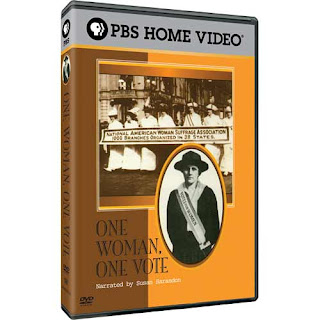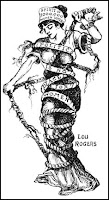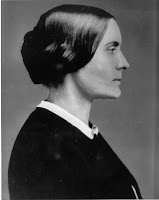 Seneca Falls. Susan B. Anthony. Elizabeth Cady Stanton. Alice Paul. Lucy Burns. Iconic American names that we recognize from our last history course, but often without knowledge of the full extent of their courage and suffering. The suffrage movement is one filled with small victories, setbacks, and defeats, and with men and women of often clashing ideas and ideologies.
Seneca Falls. Susan B. Anthony. Elizabeth Cady Stanton. Alice Paul. Lucy Burns. Iconic American names that we recognize from our last history course, but often without knowledge of the full extent of their courage and suffering. The suffrage movement is one filled with small victories, setbacks, and defeats, and with men and women of often clashing ideas and ideologies.
 Women’s suffrage was a 72-year movement that finally attained nation-wide victory in 1920 with the ratification of the 19th constitutional amendment prohibiting sex discrimination at the polls. Up to this point, women met, organized, marched, fought amongst themselves, lobbied, and protested. They were threatened, ridiculed, attacked, beaten, tried, arrested, and placed in solitary confinement for their actions. In retaliation, they fought harder. They organized hunger strikes in prison. They surrounded the White House in protest, despite angry mobs of men who dragged them to the ground and tore not only their banners, but also clothing from their bodies.
Women’s suffrage was a 72-year movement that finally attained nation-wide victory in 1920 with the ratification of the 19th constitutional amendment prohibiting sex discrimination at the polls. Up to this point, women met, organized, marched, fought amongst themselves, lobbied, and protested. They were threatened, ridiculed, attacked, beaten, tried, arrested, and placed in solitary confinement for their actions. In retaliation, they fought harder. They organized hunger strikes in prison. They surrounded the White House in protest, despite angry mobs of men who dragged them to the ground and tore not only their banners, but also clothing from their bodies.
One of the more shocking discoveries I had from watching One Woman, One Vote was that women were not united in the cause of suffrage. There were a number of women who believed that politics were corrupt, and that women would only participate in the corruption, and sully their clean, domestic image, by voting. There was even strong disagreement amongst the suffragettes; they divided and formed separate groups on different occasions, opposing each others’ strategies and tactics for earning the vote, and finally unified when ratification of the amendment seemed inevitable. There were many diverse opinions and motivations driving the movement and its opposition, including racism, temperance, religion, and cultural norms.
 The documentary was made in 1995, but only the graphics seem dated (and, despite the fact that One Woman, One Vote is part of the PBS American Experience series, the film has no official website). Susan Sarandon narrates, and the film is full of varied voices, letters, film reels, photos, and cartoons. There are great clips of historic songs throughout, too, which are often funny, incisive, and scathing. I learned so much about a part of American and women’s history that is so often summarized into a single paragraph.
The documentary was made in 1995, but only the graphics seem dated (and, despite the fact that One Woman, One Vote is part of the PBS American Experience series, the film has no official website). Susan Sarandon narrates, and the film is full of varied voices, letters, film reels, photos, and cartoons. There are great clips of historic songs throughout, too, which are often funny, incisive, and scathing. I learned so much about a part of American and women’s history that is so often summarized into a single paragraph.
Here are a few highlights of the women who made the movement.
 On November 5, 1872, Susan B. Anthony led a dozen women to the polls in Rochester, New York, and convinced the worker there to allow her and the others to vote—despite the fact that it was against the law. Four hours later, U.S. Marshals arrested and handcuffed Anthony. She was later convicted of a federal crime by an all-male jury–after being forbidden to testify on her own behalf (women were deemed incompetent to testify because of their sex). Before her sentencing, however, she was permitted a statement:
On November 5, 1872, Susan B. Anthony led a dozen women to the polls in Rochester, New York, and convinced the worker there to allow her and the others to vote—despite the fact that it was against the law. Four hours later, U.S. Marshals arrested and handcuffed Anthony. She was later convicted of a federal crime by an all-male jury–after being forbidden to testify on her own behalf (women were deemed incompetent to testify because of their sex). Before her sentencing, however, she was permitted a statement:
“In your ordered verdict of guilty, you have trampled underfoot every principle of our government: my natural rights, my civil rights, my political rights. I have been tried by law made by men, interpreted by men, administered by men, in favor of men, and against women. May it please, your honor, I shall never pay a dollar of your unjust penalty. Resistance to tyranny is obedience to God.”
 African American women were quite unified in their support of suffrage. However, mainstream groups were seeking the support of Southern Democrats, who strongly opposed suffrage for black women, and thus largely left black women out of their cause. Mary Church Terrell was one of the few black women invited to speak at national conventions, and there she urged white suffragists not to forget black women:
African American women were quite unified in their support of suffrage. However, mainstream groups were seeking the support of Southern Democrats, who strongly opposed suffrage for black women, and thus largely left black women out of their cause. Mary Church Terrell was one of the few black women invited to speak at national conventions, and there she urged white suffragists not to forget black women:
“Not only are colored women handicapped on account of their sex, they are everywhere mocked on account of their race. We are asking that our sisters of the dominant race do all in their power to include in their resolutions the injustices to which colored people are victims.”
Despite the efforts of Terrell and other African American leaders, they never enjoyed mainstream acceptance from the suffrage movement. Regardless, they organized and grew their supporters to half a million members, including active support from men.
 Elizabeth Cady Stanton, who first called for women’s rights at Seneca Falls (the right to vote was her most radical demand; the group met to call for property rights, divorce rights, and a woman’s right to her children), told her friend Susan B. Anthony that as she grew older, she grew more radical. Their relationship is widely considered one of the greatest relationships of the 19th century, and Stanton’s radicalism seems to be one of the few areas of disagreement–though it did not end their friendship. When Stanton was in her 70s, frustrated by women who still refused to join the suffrage movement, she denounced the church as responsible for the oppression of women.
Elizabeth Cady Stanton, who first called for women’s rights at Seneca Falls (the right to vote was her most radical demand; the group met to call for property rights, divorce rights, and a woman’s right to her children), told her friend Susan B. Anthony that as she grew older, she grew more radical. Their relationship is widely considered one of the greatest relationships of the 19th century, and Stanton’s radicalism seems to be one of the few areas of disagreement–though it did not end their friendship. When Stanton was in her 70s, frustrated by women who still refused to join the suffrage movement, she denounced the church as responsible for the oppression of women.
“The Bible teaches that woman brought sin and death into the world. I don’t believe that any man ever talked with God. The Bible was written by man, out of his love of domination.”
She rewrote every section of the Bible that degraded women, and published The Woman’s Bible, which was translated into six languages. The Woman’s Suffrage Association denounced the work, and rebuked Stanton. After her death, Stanton’s daughter, Harriet Blatch, led the movement.
 Alice Paul earned numerous academic degrees in her lifetime, and also served numerous prison sentences for acts of civil disobedience in her campaign for women’s suffrage. When she arrived in Washington in 1913, she was one of the few women in the United States who held a doctorate degree in political science. While in prison she led hunger strikes, and was tortured with forced-feedings:
Alice Paul earned numerous academic degrees in her lifetime, and also served numerous prison sentences for acts of civil disobedience in her campaign for women’s suffrage. When she arrived in Washington in 1913, she was one of the few women in the United States who held a doctorate degree in political science. While in prison she led hunger strikes, and was tortured with forced-feedings:
“Dear Mama,
The forcible feeding was terrible. They tied me to a chair because I struggled. One wardress sat astride my knees, two others held my arms and hands while two doctors forced a tube five or six feet long through my nose, like driving a stake into the ground.”
Rather than defeat her, the experience only made Paul more determined to devote her life to the suffrage movement. Among her many accomplishments were the organization of a parade that essentially upstaged the inauguration of newly-elected president Woodrow Wilson and caused a riot in the streets that brought out the U.S. Cavalry, and a “perpetual delegation” of women who picketed outside the White House, six days a week, in which women from all backgrounds stood silently with banners protesting the administration’s refusal to support a federal amendment to enfranchise women, and even outrageously mocking the president’s hypocrisy. Finally, police began to arrest the silent protesters, who were regularly being physically attacked, and charged them with obstructing traffic and imprisoned them–sometimes for months at a time.
The year was 1917. It took an additional three years for the 19th amendment to be passed and ratified by all of the states.
Remember the women who fought for women like us. We’ve only had the vote for 88 years. Exercise your right: Vote today.
Rent One Woman, One Vote from Netflix.
Purchase the DVD from PBS.

Elizabeth Cady Stanton is pretty much my hero. I love this quote by her:
“The women of this country ought be enlightened in regard to the laws under which they live, that they may no longer publish their degradation by declaring themselves satisfied with their present position, nor their ignorance, by asserting that they have all the rights they want.”
It’s a shame how much that still applies today …
I agree with you, Stephanie. And this was a great post to read! I’m a big fan of Susan B. Anthony. It’s astounding to me that nobody had the courage to stand up before her. We’ve only been allowed to vote for 88 years? Crazy, right?
I found a post on Peterman’s Eye today about Ms. Anthony…thought I’d share!
http://www.petermanseye.com/interesting-times/day-s-events/364-a-woman-s-right-to-vote
Cheers!
It is election day and I AM VOTING thanks to the courage of countless suffragettes!
Can you even imagine NOT being able to vote?
It saddens me that so few people know ALL of the suffering that our suffragettes had to go through, and what life was REALLY like for women.
Now you can subscribe FREE to my exciting e-mail series that goes behind the scenes in the lives of eight of the world’s most famous women to reveal the shocking and sometimes heartbreaking truth of HOW women won the vote.
Dramatic, sequential short story e-mail episodes have readers from all over the world raving about the original historical series, “The Privilege of Voting.”
Read this FREE e-mail series on your coffeebreaks and fall in love with these amazing women!
Subscribe free at
http://www.CoffeebreakReaders.com/subscribe.html
History’s non-linear way of “progressing” never fails to surprise me. The story of women’s suffrage in the U.S. is a perfect example of the snail’s pace of reform and how uneven a progressive movement can be.
At the same time, it seemed writ in the books that if “all men are created equal,” women were bound to get the vote sooner or later (unfortunately, it was later). This documentary emphasizes that regular folks needed to struggle to achieve the principles the country was founded upon. It shows how hysterical men kicked, screamed, and threw hissy fits before they corrected the law. Most importantly, it represents the vigilance of several courageous women who fought for equal rights.